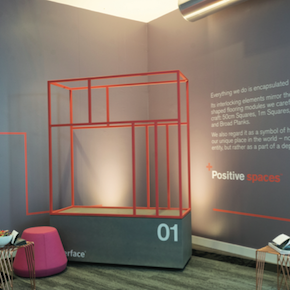
Is the WELL building standard key to creating human-centred spaces?

“Standards like WELL can provide a measurable benchmark for property developers, office designers and businesses to monitor changes they are making…” Oliver Heath
Oliver Heath, architectural designer and biophilic design ambassador at Interface, explains how the WELL Building Standard can help create more positive spaces, in the latest issue of ABC&D Magazine.
Since its launch in 2014, the WELL Building Standard (WELL), has been integral in highlighting a growing aspiration across the built environment to develop spaces that uphold the wellbeing of the people using them day-to-day.
In light of this, I joined Interface at Clerkenwell Design Week earlier this year to help host a fascinating talk with a number of industry experts discussing the importance of prioritising occupant wellbeing in the design of spaces. A key topic during the talk was the role of WELL in achieving this goal.
Wellness in the workplace
Wellbeing has moved up the built environment agenda
in recent years. This is due to the growing body of evidence demonstrating how factoring wellness into interior design can influence the physical and mental health of the people using a space.
However, this focus doesn’t just benefit building occupants. Healthier employees have been found to be more productive and more engaged in the workplace, helping to enhance business output in turn. As Victoria Lockhart of the WELL Building Institute noted during the talk: “Strategies that we can deploy within a workplace to help individuals perform at their peak have a strong correlation with the economic performance of an organisation.”
Thanks to these notable business advantages, a growing number of commercial property developers are looking for ways to show their tenants that buildings can help businesses uphold the health of their workers. They are keen to benchmark their properties against competitors according to their impact on occupant wellness.
This is where WELL comes in. There are three certification levels; silver, gold and platinum that are achieved through implementing the seven core features; improving the delivery of air, water, food, light, fitness, comfort (physical) and mind (mental wellbeing).
Well building
A number of projects are already being built with the
new standard in mind. One key example is the recent refurbishment of the London office of Cundall – a global engineering consultancy. As part of Interface’s discussion, Alan Fogarty, sustainability partner at Cundall, spoke about his experience meeting WELL. He explained how he was keen to utilise the standard’s design strategies throughout the office.
In addition to working with a designer to create a new layout for the office space, Alan explored other factors to ensure wellness in the office. Everything from reducing the presence of volatile organic compounds (VOCs) in glues and paints, to the ergonomics of workstations and the design of catering facilities were addressed in the renovation.
Ben Allen of Ben Allen Studio was the architect behind the refurbishment of the space, and he was particularly interested in exploring ways to change occupants’ behaviour for the better.
Ben wished to inspire workers to move around the office more, so endeavoured to create a sense of openness. Smaller desks were chosen and positioned near the walls, creating additional space in the centre of the room to encourage people to actively leave their workstations and communicate with each other more often.
Alan reports that the in-depth focus on every aspect of workplace wellness has had a highly positive impact. He quotes significant gains in staff retention, productivity and a 50% drop in absenteeism over previous years’ levels – saving the organisation around £200,000. This kind of result clearly demonstrates how placing a human-centred design approach at the heart of the built environment has significant potential for businesses.
The journey ahead
In spite of all of this progress, as Ed Suttie of BRE highlighted during the talk, there is still a long way to go for WELL and the integration of wellness into building design. Ed pointed out that: “In European offices, we have a problem: according to Interface’s Human Spaces report1, 42% of European employees still have no natural light, 55% have no access to greenery and 7% have no windows at all.”
Evidently, more needs to be done to tackle the deficit in human-centred office design. Standards like WELL can provide a measureable benchmark for property developers, office designers and businesses to monitor changes they are making. Such certification can help our industry ensure that we are providing the best possible environment to support workers’ health and inspire creativity.
Latest news

21st February 2025
ASSA ABLOY EMEIA: Save valuable time and money with a seamless switch to programmable digital keys
In 2025, access management can be a whole lot easier. By making access part of their digital processes, businesses can put time-consuming key management and the cost of changing the locks firmly behind them. Making this switch is a lot easier than many people think, as ASSA ABLOY explains here…
Posted in Access Control & Door Entry Systems, Architectural Ironmongery, Articles, Building Industry News, Building Products & Structures, Building Services, Doors, Facility Management & Building Services, Health & Safety, Information Technology, Innovations & New Products, Retrofit & Renovation, Security and Fire Protection
21st February 2025
Showersave supports industry leaders in addressing Part L and Part G regulations
Showersave has sponsored and participated in a recent Building Insights LIVE roundtable on ‘Water & Energy Saving Innovations in New Build Housing’.
Posted in Articles, Bathrooms & Toilets, Bathrooms, Bedrooms & Washrooms, Building Associations & Institutes, Building Industry Events, Building Industry News, Building Products & Structures, Building Regulations & Accreditations, Building Services, Exhibitions and Conferences, Interiors, Pipes & Fittings, Plumbing, Retrofit & Renovation, Sustainability & Energy Efficiency
21st February 2025
GEZE: The importance of Specifying High Quality Door Closers on Fire Doors
Andy Howland, Sales & Marketing Director at GEZE UK, discusses why specifying high quality door closers on fire doors is important…
Posted in Access Control & Door Entry Systems, Accessibility, Architectural Ironmongery, Articles, Building Industry News, Building Products & Structures, Building Regulations & Accreditations, Building Services, Doors, Facility Management & Building Services, Health & Safety, Posts, Restoration & Refurbishment, Retrofit & Renovation, Security and Fire Protection
21st February 2025
Insight Data achieves ISO9001 recertification with zero non-conformities
Leading industry data specialist, Insight Data, has successfully achieved the prestigious recertification for ISO9001 with zero non-conformities for the fourth consecutive year.
Posted in Articles, Building Industry News, Building Regulations & Accreditations, Building Services, Information Technology, Research & Materials Testing
 Sign up:
Sign up: